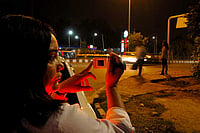Why Do They Squirm?
- Children from poor homes are perceived to be unhygienic
- Speak crudely; can’t speak English and slow down the pace of the class
- They’ll be humiliated around rich kids as they can’t afford expensive school trips and school uniforms
- The richer parents will end up paying higher school fees
- They will have to attend PTA meetings with lower-class parents
***
The gloom at the Sharma household, in an unauthorised southwest Delhi colony, lifted last month. Four-year-old Daksh had finally made it into a private school. “After three months of doing the rounds at over 30 private schools, he’s in. I still can’t believe it,” says Komal Sharma, his relieved mother. Turned away by every school—one demanded Rs 50,000 to admit him, it took a letter from the ministry of education for Komal and her husband, a commercial vehicle driver, to get Daksh enrolled. His school is less fancy than the G.D. Goenka and DPS on her wishlist, but Komal says, “At least he made it to a private school. The dreams we have for him can’t sustain in a government school.”

‘Relief’...but Komal Sharma had a tough go of it, while seeking a school for Daksh. (Photograph by Jitender Gupta)
For parents like the Sharmas, the going may now get a tad easier with the 25 per cent reservation for the Economically Weaker Section (EWS) at the nursery and class 1 entry levels in all private schools. Vatsala Mamgain, a mother of two who sends two children to an elite Delhi school, knows all too well what a good education can do. Her father, the oldest of nine, was responsible for the whole family. He’d benefited from a similar opportunity in a top private school. “The door that his education opened for him makes me believe that while there will be issues in having children from different backgrounds study together, the alternative is so much worse,” says Mamgain. Agrees Meena Vaidyanathan, a Tezpur-based social entrepreneur, whose 10-year-old son attends a school with children from mixed-income groups. “I too studied in a school where my classmates were kids of local shopkeepers, door-to-door salesmen, while we were middle class. That proved to be a great leveller for me.” In Calcutta, TV writer Mousumi Choudhury, whose son is in class 9 at a private school, has strong views on elitism. “It is our collective responsibility to extend a good environment to underprivileged children,” she says. Though there’s positivity aplenty, many wonder how gadget-loving, mall-trawling kids will cope in a mixed group. “I didn’t like the expression on my daughter’s face when I explained the reservation issue to her. She wondered how EWS kids would speak English. But kids are so adaptable, I wouldn’t worry,” says Gurgaon-based Shirani Mehta, who sends her two children to an expensive international school in Delhi.

| “If the reservation comes into force, schools will tax us more. Ultimately, the middle-class parents will pay through the nose.” Jayati Saha, Parent of private schoolers |

| “Being in a private school has given my daughter such confidence. Her base will be good. She topped her class this year. ” Madhu Bala, Parent, EWS private schooler | ||

| “It is a challenge for the teachers. There are wide disparaties, right from tiffin boxes down to hygiene and language.” Manika Sharma, Principal, The Shri Ram School |

| “The rich will be negative about the integration. The government must ensure the process is firmly implemented.” Madhav Chavan, Founder, Pratham |
But for every positive opinion, there is a blunt, less empathic one in opposition. “We pay Rs 1.8 lakh p. a. to send our daughters to a private school. If the reservation comes into force, the school management will end up taxing us more. So, ultimately, it is the middle class who will pay through the nose,” says Jayati Saha, of Hyderabad, adding: “I’m also concerned that the language these children speak might affect my daughters.” For a large section of the middle class, it’s a class divide that simply cannot be bridged. There are stories of the rich boycotting schools that admit EWS students, unsavoury whispers about poor children being “thieves”, “unhygienic” and “bad company”. And there are other niggles. Not a few middle-class parents Outlook spoke to felt an EWS child would feel inferior and “humiliated” around rich children. “I am not against the RTE,” says a mother of two daughters studying in an elite school in Delhi, who asked not to be named, “but poor children would just feel uncomfortable attending elite schools. Instead of giving them 25 per cent reservation in private schools, why can’t the government allot them 100 per cent in government schools? Or, if they want them to attend private schools, then organise afternoon shifts for them,” she says.
With the Supreme Court verdict, class wars—between parents, the schools and the students—are being waged out in the open in many metros. “It’s really not that hard to include EWS children in the private school system. The opposition to it just shows the medieval mindset of the rich schools and parents,” says Kiran Bhatty, national RTE commissioner at the National Commission for Protection of Child Rights. It’s really our attitude that need a rethink, feels Delhi’s Sanskriti School principal Abha Sahgal. “We are not doing anyone a favour by including EWS children in our school. Yes, they need extra support, but we work at removing their inhibitions and confusion. And then watch their confidence levels soar—we even have EWS students who have been shortlisted for the Student’s Council this year,” she says. Her school has had seats reserved for poor children since its inception, and she says the results have been heartening.

Her shot Nabya, an EWS student at Ryan International School, with her mother. (Photograph by Jitender Gupta)
But the majority of Indian schools have not taken kindly to being “pushed” into taking in non-paying poor students. In Hyderabad, private schools are lobbying against the court judgement and say they will demand a review. And then there’s that old don’t-infringe-on-my-land sentiment. Professor K. Narender, Department of Communication and Journalism, Osmania University, says, “If the reservation is 25 per cent today, tomorrow the percentage might go up. Where will the middle class go then?” Many schools say there are real problems and there is no point in hiding behind a veil of equality. At Delhi’s elite Shri Ram School, where poor students have attended classes for the last four years, principal Manika Sharma admits the success rate is minuscule. “It’s a big challenge for the teacher community. There is a glaring disparity, right from tiffin boxes down to language, school trips. We’re trying, though, by giving them extra support and holding classes on health and hygiene and social skills.”
It’s to be expected that throwing in students from different income-groups together is likely to throw up umpteen issues. “Rather than shy away from them, teachers, parents and children have to be sensitised on the socio-cultural issues arising out of gross income disparities,” says Aruna Sankaranarayanan, founder-director of Prayatna, a community helping students enhance skills needed in the mainstream classroom. “There is such a hypocrisy in rich schools opposing this when they claim they are not running a business! Then they shouldn’t be resistant to charity, right?” asks Madhav Chavan, founder of Pratham, an organisation working to educate the underprivileged.
Madhu Bala isn’t concerning herself with such debates. She can’t afford to. Her daughter Nabya has to be packed off to Ryan International School every morning from their two-room home in Jahangirpuri, north Delhi. A homemaker, Madhu began holding tuition classes to supplement her husband’s income after Nabya bagged a seat via the EWS quota. They now have to shell out Rs 400 a month for the private van that takes her to school, in addition to fees for uniforms and textbooks. “My daughter asked me for a new watch the other day and I told her frankly that we can’t afford it. These problems will grow as she gets older and mixes more with rich children. But at the end of the day, her academic base will be strong. That’s all that matters,” Madhu says. Nabya has her shot at a better education and a brighter future. Will the millions like her all over India get theirs?
By Neha Bhatt inputs by Dola Mitra and Madhavi Tata


























